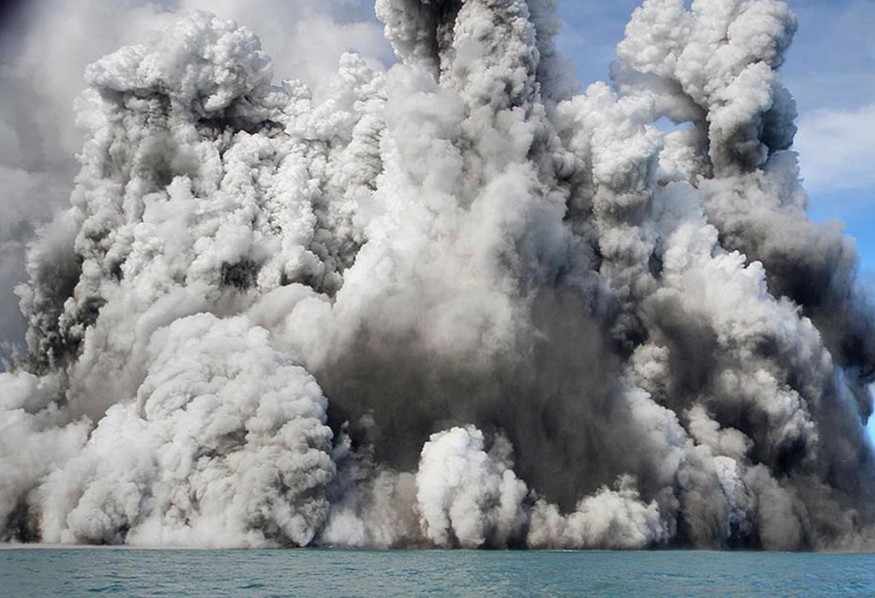The Tonga eruption has happened regularly for the last few decades, and during these occurrences in 2009, 2014, and 2015, hot jets of steam and magma exploded through the waves.
However, these eruptions were small, dwarfed in measure by the occurrences of January 2022. According to a Scientific American report, the Kingdom of Tonga does not frequently entice global attention, although a violent eruption of an underwater volcano in mid-January has spread shock waves, somewhat literally around half the globe.
Typically, the volcano is not much to look at. It comprises two tiny inhabited islands, namely, the Hunga-Ha'apai and Hunga-Tonga, poking roughly 100 meters above sea level, 65 kilometers north of the capital Nuku'alofa of Tonga. However, a gigantic volcano hides beneath the waves, approximately 1,800 meters high and 20 kilometers wide.
The study into such earlier eruptions proposes this is one of the large explosions the volcano can produce approximately every thousand years.
ALSO READ : Scientists Tests Laws of Friction To Understand Caldera Collapse During Kilauea Volcano Eruption in 2018

Why Are the Tonga Eruptions Highly Explosive?
In the study published in Eos Science News by AGU, the researchers found that if magma rises into seawater gradually, even at an estimated 1,200 degrees Celsius, a thin film of a stream is forming between water and magma. This produces an insulation layer to allow the outer surface of the magma to cool.
However, this process does not work when magma gets blasted out of the ground, filled with volcanic gas. When magma quickly enters the water, any layers of steam are disrupted fast, "bringing hot magma in direct contact with cold water," as specified in a report by The Conversation, where this report first came out.
Researchers of volcanoes call this "fuel-coolant interaction," similar to weapons-grade chemical explosions. Tremendously violent blasts are tearing the magma apart.
A chain reaction starts with new magma fragments that expose fresh hot inner surfaces to water, and the explosions happen again, eventually jetting out volcanic particles and resulting in blasts "with supersonic speeds."
Volcanic Cone Created
The 2014/15 eruption produced a volcanic cone the joined the two old Hunga islands to generate a combined island roughly five kilometers long.
Then, in 2016, the researchers visited in 2016 and found that the historical eruptions were curtained raisers to the main occurrence. They mapped the seafloor and discovered a "hidden caldera" 150 meters underneath the waves.
Essentially, the caldera is described as a crater-like depression approximately five kilometers across. Minor eruptions like in 2009 and 2014/15 place mainly at the edge of the caldera, although major ones come from the caldera itself.
These massive eruptions are so huge that the top of the erupting magma collapses inward, making the caldera deeper.
What's Next?
This is only the middle of a major explosive sequence, and numerous aspects remain unclear, partly because ash clouds presently obscure the island.
The two previous occurrences of eruptions in December 2021 and earlier this month were reported to be "of moderate size. They generated clouds of up to 17-kilometer elevation and added new land to the combined island during the 2014/15 eruption.
The most recent eruption, reported in The Science Times on January 15, has stepped up the measure in terms of violence.
The ash plume is already roughly 20 kilometers high. Most notably, it spread out nearly concentrically over an approximately 130-kilometer distance from the volcano, producing a plume with a diameter of 260 kilometers before the wind distorted it.
This exhibits a massive explosive power, which cannot be explained alone by the interaction between magma and water.
It shows that big amounts of fresh, gas-charged magma have exploded from the caldera. The eruption also generated tsunami all over Tonga and neighboring Samoa and Fiji.
The Large Caldera Has Awoken
All the signs mentioned hint the large Hunga caldera has awoken. Tsunamis are produced by combined atmospheric and ocean shock waves during explosions, although they are readily caused by submarine landslides and caldera collapses.
It is still not clear if it is the eruption's climax. It represents a major release of magma pressure, which may slow or calm down the system.
However, a warning lies in the geological deposits from the volcano's past eruptions. Those multifaceted sequences exhibit each of the 1000-year major eruption episodes of the caldera involved numerous separate explosion occurrences.
Report about the January 15 Tonga eruption is shown on the South China Morning Post's YouTube video below:
RELATED ARTICLE : Kīlauea Caldera Survey Helps Check Possible Changes in Volcano's Gas Emissions After 2018 Eruption
Check out more news and information on Volcanoes in Science Times.
© 2025 ScienceTimes.com All rights reserved. Do not reproduce without permission. The window to the world of Science Times.












